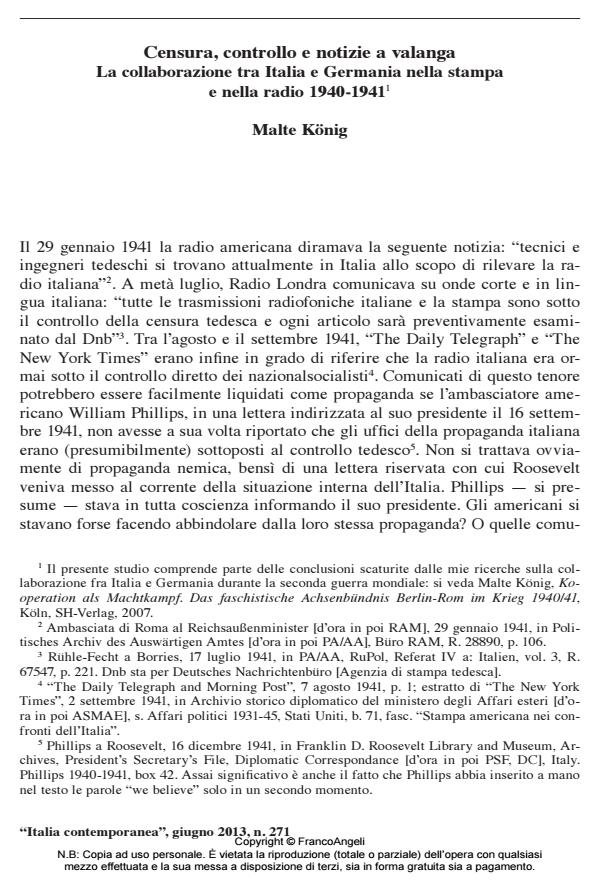Censura, controllo e notizie a valanga. La collaborazione tra Italia e Germania nella stampa e nella radio 1940-1941
Titolo Rivista ITALIA CONTEMPORANEA
Autori/Curatori Malte Konig
Anno di pubblicazione 2013 Fascicolo 2013/271
Lingua Italiano Numero pagine 23 P. 233-255 Dimensione file 341 KB
DOI 10.3280/IC2013-271003
Il DOI è il codice a barre della proprietà intellettuale: per saperne di più
clicca qui
Qui sotto puoi vedere in anteprima la prima pagina di questo articolo.
Se questo articolo ti interessa, lo puoi acquistare (e scaricare in formato pdf) seguendo le facili indicazioni per acquistare il download credit. Acquista Download Credits per scaricare questo Articolo in formato PDF

FrancoAngeli è membro della Publishers International Linking Association, Inc (PILA)associazione indipendente e non profit per facilitare (attraverso i servizi tecnologici implementati da CrossRef.org) l’accesso degli studiosi ai contenuti digitali nelle pubblicazioni professionali e scientifiche
Durante tutta la seconda guerra mondiale, la cooperazione all’interno dell’Asse Roma-Berlino risentì di sfiducia e rivalità. Partendo da questo fatto, il saggio analizza se, in che modo e in quale misura i nazionalsocialisti abbiano esercitato un’ingerenza sui media italiani. L’autore dimostra non solo che la collaborazione tra italiani e tedeschi nel settore della propaganda fu soprattutto utilizzata da questi ultimi per esercitare un controllo sulla stampa e la radio fasciste - cosa di per sé non sorprendente -, ma anche che le aspettative tedesche non si realizzarono nel modo sperato. Come sul piano economico e militare, anche nel settore dell’informazione si resero più che evidenti le difficoltà che inevitabilmente sorgevano per la Germania nel rapportarsi con un partner senza dubbio inferiore, ma comunque sovrano: entro certi limiti, la fornitura di notizie rendeva possibile un blando condizionamento, ma le veline difficilmente potevano imporre divieti. A creare i maggiori problemi fu soprattutto la divulgazione da parte dei media italiani, a dispetto degli interventi di Pavolini e dello stesso duce, di segreti militari.
Parole chiave:Seconda guerra mondiale, Asse Roma-Berlino, stampa fascista, radio fascista, segreti militari, Alessandro Pavolini
Malte Konig, Censura, controllo e notizie a valanga. La collaborazione tra Italia e Germania nella stampa e nella radio 1940-1941 in "ITALIA CONTEMPORANEA" 271/2013, pp 233-255, DOI: 10.3280/IC2013-271003